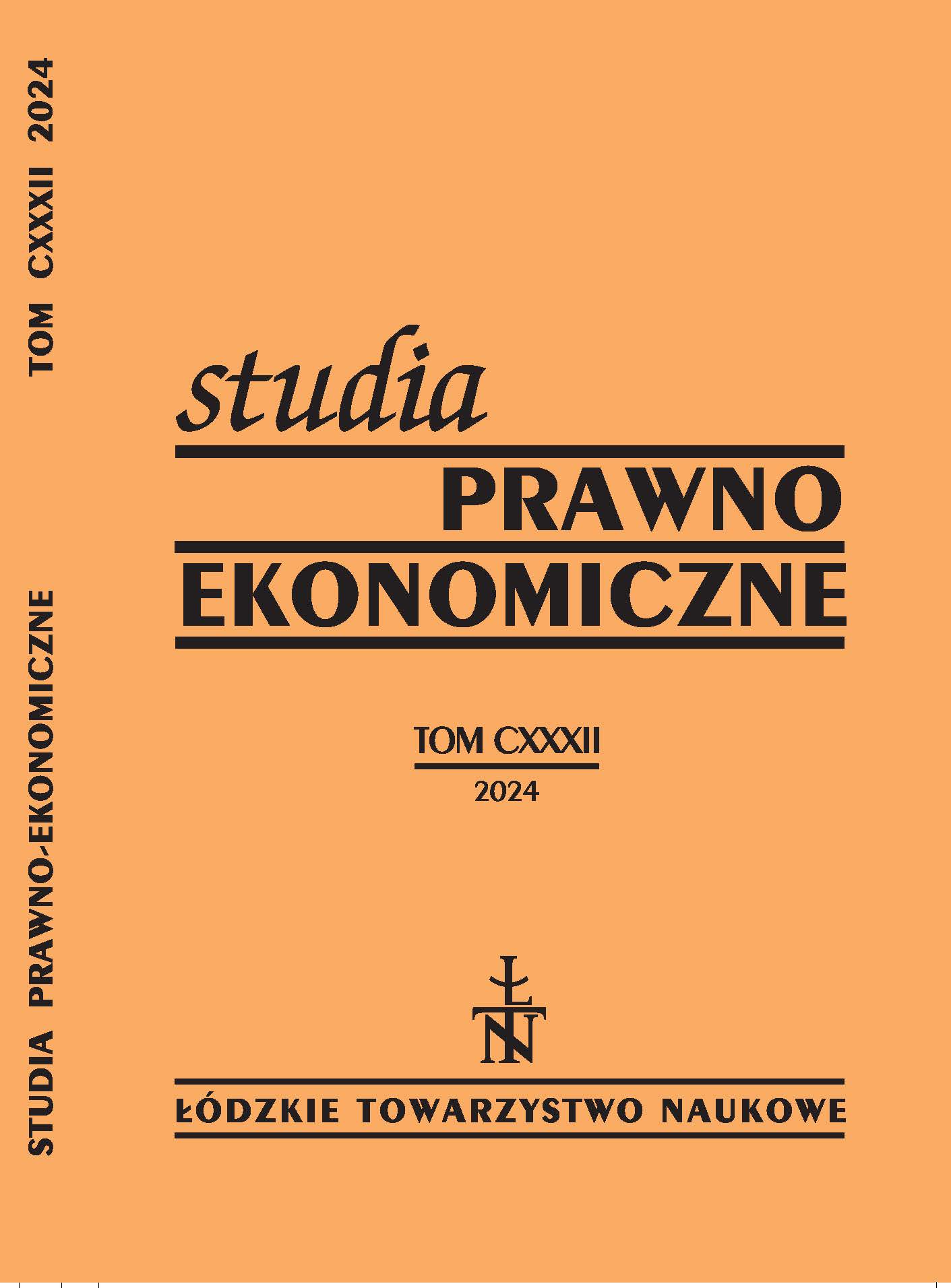Competitiveness of the Świętokrzyskie voivodship with particular emphasis on the environmental aspect
DOI:
https://doi.org/10.26485/SPE/2024/132/7Keywords:
environmental competitiveness, environment, environmental protection.Abstract
Background: A significant influence on the development of regional competitiveness issues is exerted by the regional policy of the European Union, one of whose priorities is to raise the level of competitiveness of territorial units. The increased importance of the concept of sustainable development has resulted in the importance of traditional competitiveness factors declining and the environment playing an increasingly important role in shaping regional competitiveness. Despite this, an existing research gap in the literature regarding the assessment of the competitiveness of the environmental aspect can currently be observed.
Research purpose: The aim of the study was to assess the overall level of competitiveness of the Świętokrzyskie voivodeship in comparison with other regions in the country, as well as competitiveness taking into account only the environmental aspect.
Methods: An assessment of the level of competitiveness of the Świętokrzyskie voivodeship was carried out on the basis of the Regional Competitiveness Index published by the European Commission. Perkalʼs linear ordering method was used to assess the competitiveness of the environmental aspect. In order to construct an environmental competitiveness model, 28 state and environmental variables were used, which were divided into 8 groups relating to different environmental categories. Variables were selected for the model by using Cronbachʼs alpha reliability analysis, coefficient of variation and correlation coefficient matrix. In addition, using descriptive statistics elements, the regions of Poland were grouped according to similar levels of environmental competitiveness.
Conclusions: The Świętokrzyskie voivodeship was characterised by one of the lowest levels of competitiveness in Poland, which was mainly due to insufficient development of transport and technical infrastructure, a relatively high level of unemployment and a low level of innovation. An increasingly important aspect in building regional competitiveness are issues related to the state and protection of the environment. Specific actions to improve the environmental aspect should be undertaken in the Świętokrzyskie voivodeship, which was characterised by a low level of environmental competitiveness as a result of e.g. inadequate air quality, low level of sewerage or decreasing expenditures on environmental protection. In none of the analysed categories related to the environment did the voivodeship have a competitive advantage over other Polish regions. An opportunity to improve the environmental competitiveness of Świętokrzyskie voivodship is the implementation of smart specialisations, which in the region were formulated in such a way that the activities undertaken in their framework take advantage of the regionʼs assets and natural resources.
Downloads
References
Ahmad M.A., Ziaullah M., Tariq M.G., The Rise of Green Competitiveness: A Global Study from Scopus Database, Global Social Sciences Review 2023/8, s. 554–568.
Dzikowska M., Gorynia M., Jankowska B., Teoretyczne, empiryczne i metodologiczne aspekty konkurencyjności przedsiębiorstw, w: M.
Dzikowska, M. Gorynia, B. Jankowska (red.), Międzynarodowa konkurencyjność polskich przedsiębiorstw w okresie globalnego kryzysu gospodarczego i po jego wystąpieniu, Difin, Warszawa 2016, s. 98–131.
Falkowski K., Sustainable Competitiveness of the Visegrad Group Countries, Optimum. Economic Studies 2023/1, s. 3–19.
Grabowska A., Konkurencyjność regionu a kapitał społeczny, Studia Ekonomiczne / Uniwersytet Ekonomiczny w Katowicach 2013/156, s. 189–198.
Gralak K., Biogospodarka jako obszar inteligentnej specjalizacji regionalnej, Zeszyty Naukowe SGGW, Polityki Europejskie, Finanse i Marketing 2015/63, s. 65–74.
Herodowicz T., Środowiskowe uwarunkowania rozwoju regionalnego – kontekst teoretyczny, Folia Pomeranae Universitatis Technologiae Stetinensis. Oeconomica 2014/76, s. 57–72.
Jegorow D., Odmienne priorytety rozwojowe polskich województw w kontekście absorpcji funduszy europejskich w latach 2004-2013, w: H. Brandenburg, P. Sekuła (red.), Projekty regionalne i lokalne – sukces projektu, Wydawnictwo Uniwersytetu Ekonomicznego w Katowicach, Katowice 2016, s. 149–165.
Kasztelan A., The green competitiveness of Polish regions, Prace Naukowe Uniwersytetu Ekonomicznego we Wrocławiu 2020/64, s. 32–41.
Kouskoura A., Kalliontzi E., Skalkos D., Bakouros I., Assessing the Key Factors Measuring Regional Competitiveness, Sustainability 2024/16, s. 1–23.
Kukushkina A.V., Mursaliev A.O., Krupnov Y.A., Alekseev A.N., Environmental competitiveness of the economy: Opportunities for its improvement with the help of AI, Frontiers in Environmental Science 2022/10, s. 1–6.
Malkowski A., Wielowymiarowa analiza przestrzennego zróżnicowania rozwoju społeczno-gospodarczego województw w latach 1999–2004, Folia Universitatis Agricultate Stetinensis. Oeconomica 2007/48, s. 205–212.
Masłoń-Oracz A., Konkurencyjność regionu Stuttgart i Śląsk: przykłady skutecznie wdrażanej strategii inteligentnej specjalizacji, w: Z. Czachór, T. Marcinkowski (red.), Polska – Niemcy – Unia Europejska: razem czy osobno? Praca zbiorowa, Dom Wydawniczy Elips, Warszawa 2017, s. 131–144.
Medeiros V., Godoi L., Teixeira E., Competitiveness and its determinants: A systemic analysis for developing countries, CEPAL Review 2019/129, s. 7–25.
Nowak A., Kasztelan A., Economic competitiveness vs. green competitiveness of agriculture in the European Union countries, Oeconomia Copernicana 2022/2, s. 379–405.
Ręklewski M., Statystyka opisowa. Teoria i przykłady, Wydawnictwo Państwowej Uczelni Zawodowej we Włocławku, Włocławek 2020.
Sagan A., Analiza rzetelności skal satysfakcji i lojalności, StatSoft Polska 2003/1, s. 39–52.
Surówka A., Konkurencyjność województw Polski Wschodniej na tle regionów Unii Europejskiej w świetle badań własnych, Nierówności Społeczne a Wzrost Gospodarczy 2014/39, s. 394–407.
Szostak E., Inteligentne specjalizacje w rozwoju regionu, Studia Ekonomiczne 2015/209, s. 209–217.
Wojarska M., Konkurencyjność województwa świętokrzyskiego na tle pozostałych regionów Polski, Studia i Materiały. Miscellanea Oeconomicae 2014/3, s. 129–143.
United Nations, Transforming Our World: The 2030 Agenda For Sustainable Development, New York 2015.
Rezolucja Parlamentu Europejskiego z dnia 13 września 2022 r. w sprawie nowej strategii leśnej UE 2030 – zrównoważona gospodarka leśna w Europie (2022/2016(INI)).
Uchwała nr 3459/21 Zarządu Województwa Świętokrzyskiego z dnia 10 marca 2021 r. w sprawie przyjęcia Regionalnej Strategii Innowacji Województwa Świętokrzyskiego 2030+.
EU Regional Competitiveness Index 2.0 - 2022 edition, https://ec.europa.eu/regional_policy/assets/regional-competitiveness/index.html#/PL; stan na 13.02.2024 r.
The European Green Deal. A growth strategy that protects the climate, https://ec.europa.eu/stories/european-green-deal/; stan na 7.02.2024 r.
Downloads
Published
How to Cite
Issue
Section
License
Copyright (c) 2024 Studia Prawno-Ekonomiczne

This work is licensed under a Creative Commons Attribution 4.0 International License.







